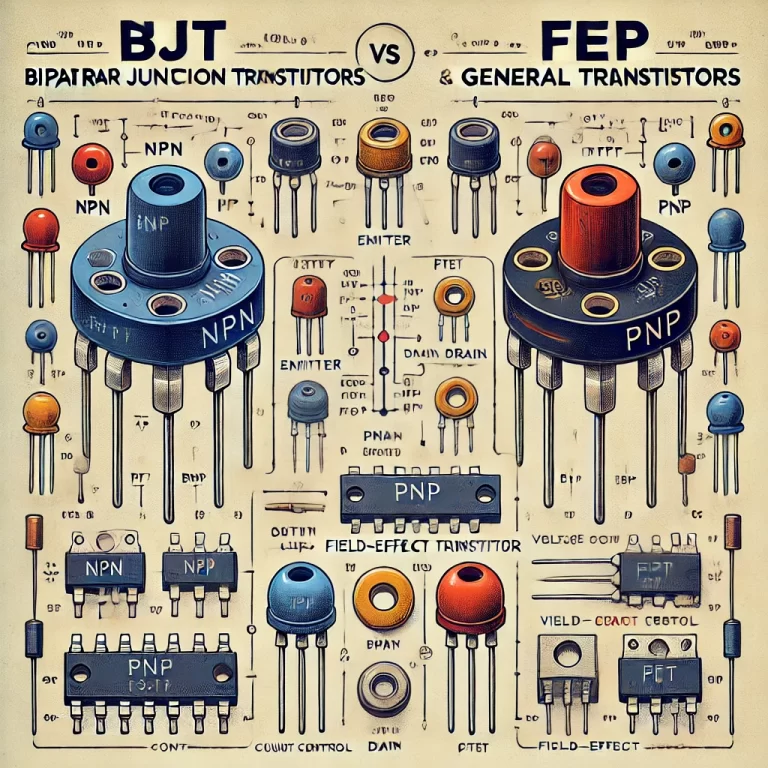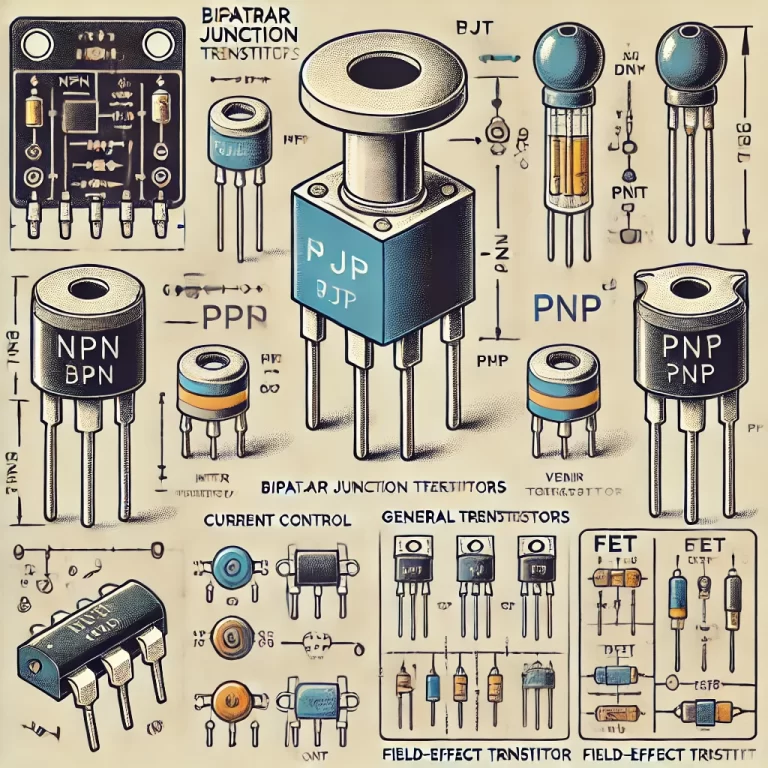1. Introduction
Transistors and bipolar junction transistors (BJTs) are fundamental components in electronics, playing crucial roles in signal amplification, switching control, and power regulation. Although the terms “transistor” and “BJT” are sometimes used interchangeably in casual discussions, they have distinct meanings in technical and historical contexts. This article explores the differences between transistors and BJTs, their working principles, applications, and their role in modern electronics.
2. Definitions
2.1 Definition of Bipolar Junction Transistors (BJTs)
Historically, the term “BJT” specifically refers to bipolar junction transistors, which were among the earliest types of transistors developed. A BJT consists of three terminals:
Emitter (E)
Base (B)
Collector (C)
BJTs operate based on current control: a small current at the base terminal controls a larger current flowing between the collector and emitter. BJTs come in two types:
NPN transistors (electrons are the majority carriers)
PNP transistors (holes are the majority carriers)
2.2 Definition of Transistors
The term “transistor” is a broader category that includes all semiconductor devices capable of amplification and switching, including:
BJTs (Bipolar Junction Transistors)
FETs (Field-Effect Transistors), which include:
JFETs (Junction Field-Effect Transistors)
MOSFETs (Metal-Oxide-Semiconductor Field-Effect Transistors)
Unlike BJTs, which are current-controlled, FETs are voltage-controlled devices. This fundamental difference results in varied applications and performance characteristics.

3. Key Technical Differences
3.1 Structural Differences
BJTs are made up of three alternating layers of semiconductor material, forming either an NPN or PNP structure:
| Type | Emitter | Base | Collector |
|---|---|---|---|
| NPN | N-type | P-type | N-type |
| PNP | P-type | N-type | P-type |
In contrast, FETs have a different structure consisting of three key terminals:
Source (S)
Drain (D)
Gate (G)
FETs operate based on an electric field that controls current flow between the source and drain.
3.2 Working Principle Differences
| Feature | BJT (Bipolar Junction Transistor) | FET (Field-Effect Transistor) |
| Control Type | Current-controlled | Voltage-controlled |
| Input Requirement | Requires base current | Requires gate voltage |
| Input Impedance | Low | High (near infinite) |
| Switching Speed | Generally slower | Faster, especially MOSFETs |
| Power Consumption | Higher due to base current | Lower due to voltage control |
BJTs: A small base current (IB) controls a much larger collector current (IC). This amplification property makes BJTs ideal for analog amplification circuits.
FETs: A voltage applied at the gate controls the current between the source and drain. Due to their high input impedance and low power consumption, FETs are widely used in digital circuits and modern processors.
3.3 Application Differences
| Feature | BJT Applications | FET Applications |
| Signal Amplification | Audio amplifiers, RF amplifiers | Operational amplifiers, analog circuits |
| Switching Circuits | Low-frequency power switches | High-speed digital switching, MOSFET power circuits |
| Integrated Circuits | Still used in some analog ICs | Dominant in modern ICs, microprocessors |
| Power Consumption | Higher (base current requirement) | Lower (voltage-driven) |
BJTs are still preferred in applications requiring high gain and linearity, such as:
Audio amplifiers
Analog signal processing
RF circuits (though FETs are gaining popularity here as well)
FETs, particularly MOSFETs, dominate digital electronics due to:
High input impedance (less power required for control)
Fast switching speed (ideal for high-frequency circuits)
Lower power consumption (critical for battery-operated devices like smartphones and laptops)
4. Modern Technological Developments
With advancements in semiconductor technology, transistors have undergone significant miniaturization and performance improvements. Some key developments include:
4.1 Miniaturization
FinFET (Fin Field-Effect Transistor): A 3D transistor architecture used in modern processors (5nm, 3nm technology nodes)
Nanoscale MOSFETs: Used in state-of-the-art microprocessors, enabling billions of transistors in a single chip
4.2 Emerging Technologies
Graphene and Carbon Nanotube Transistors: Potential successors to silicon-based transistors, promising higher speed and lower power consumption
Optoelectronic Transistors: Transistors that use light for switching, paving the way for photonic computing
These innovations are shaping the future of electronics, enabling faster, smaller, and more energy-efficient devices.

5. Conclusion
While the term “transistor” refers to a broad category of semiconductor devices, BJT (Bipolar Junction Transistor) is just one type of transistor. Understanding the differences between BJTs and other transistor types, such as FETs and MOSFETs, is essential for designing modern electronic circuits.
BJTs excel in high-gain analog applications and power amplification.
FETs (especially MOSFETs) dominate digital electronics, microprocessors, and power-efficient systems.
As semiconductor technology continues to evolve, transistors remain at the heart of technological advancements, from smartphones to AI-driven computing.
Key Takeaways
BJTs are a type of transistor, but not all transistors are BJTs.
BJTs are current-controlled, while FETs are voltage-controlled.
MOSFETs dominate modern digital and integrated circuits due to lower power consumption and faster switching speeds.
New transistor technologies like FinFETs and nanoscale MOSFETs are driving next-generation computing.
Understanding these differences is crucial for engineers and electronics enthusiasts alike, ensuring the optimal selection of components for various applications.
